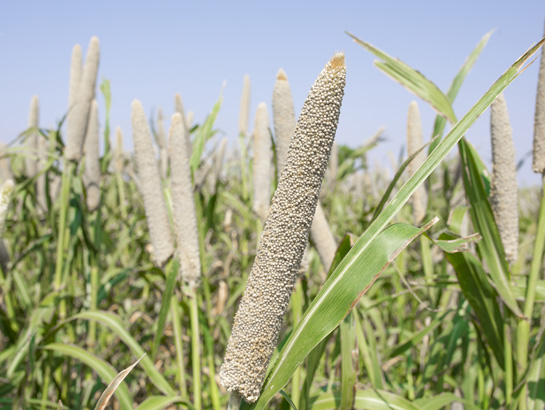Niger is a hot-spot for pearl millet production and consumption globally. It is host to an array of pearl millet diversity, but farmers in the region suffer from low grain yields due to environmental constraints like low soil fertility, drought, and pests.
Around 30 varieties of pearl millet have been released in Niger—including nutrient-enriched iron pearl millet, developed and released by the National Agricultural Research System in association with HarvestPlus and ICRISAT, under the CGIAR Research Program. Nonetheless, farmers continue to predominantly cultivate varieties with levels of iron and zinc lower than in the improved nutrient-enriched varieties.
In the Sahel region, where farmers tend to eat what they grow, pearl millet is eaten every day. As a key dietary staple, it has a critical role in population food and nutrition security.
Engaging farmers to understand their food preferences and needs, and access to seeds, is a crucial step towards influencing the adoption of varieties that could integrate more nutrition and resilience into the food system.
The Food and Agriculture Organization of the United Nations declared 2023 the International Year of the Millets, to promote their adoption and raise awareness of their high nutritional content, adaptability, and income-generating potential.
To assess the opportunities to scale up iron pearl millet and mainstream more nutritious varieties in the seed system, a study was undertaken in 12 villages across the Dosso region of Niger. The Dosso region is home to 2.3 million people and, as one of the most micronutrient -deficient areas in the country, stands to benefit significantly from agricultural-based nutrition solution. Women and men farmers were asked questions to understand the traits of pearl millet they preferred and how and where they accessed quality seeds.
The study published in Agronomy found that farmers are unanimously interested in growing nutrient-enriched iron pearl millet, especially to benefit children and breastfeeding women. Its high iron and zinc content and competitive yield were appealing.
“Farmers in the Dosso region tend to grow traditional varieties with low yield and prefer millets with big, long grains,” said Mahalingam Govindaraj, co-author of the publication and HarvestPlus Senior Scientist for Crop Development. “It’s important to increase awareness and access to improved varieties that are higher in nutrition, early maturing, and have these traits that farmers want. Adoption of iron pearl millet could help spur on improved production in this and other regions in Niger.”
Early maturity was found to be the most important trait to both women and men farmers. Poor soil and drought were the biggest constraints to production, challenges that can be addressed by good agronomic practices and through selective breeding programs that prioritize nutrient density alongside agronomic productivity.
Released iron pearl millet varieties are very early maturing, making them ideal for cultivation under drought conditions, and tolerant to downy mildew, a major disease that hinders pearl millet growth.
Nutrient-enriched varieties of pearl millet could improve the nutrition and health of resource-poor households in Niger. This study provided important insights to help establish priorities for pearl millet breeding programs. Meeting farmers’ needs will help accelerate the mainstreaming of vital nutrition and agronomy traits into pearl millet in West Africa, building a resilient agrifood system from seed to plate.
